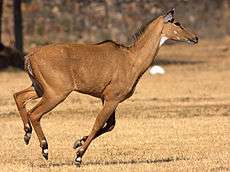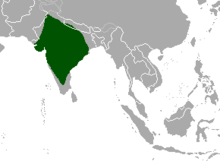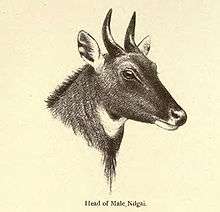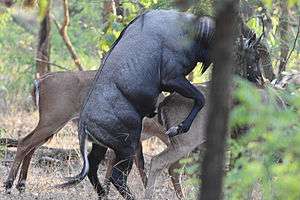Nilgai
| Nilgai | |
|---|---|
 | |
| Nilgai in India | |
| Scientific classification | |
| Kingdom: | Animalia |
| Phylum: | Chordata |
| Class: | Mammalia |
| Order: | Artiodactyla |
| Family: | Bovidae |
| Subfamily: | Bovinae |
| Genus: | Boselaphus Blainville, 1816 |
| Species: | B. tragocamelus |
| Binomial name | |
| Boselaphus tragocamelus (Pallas, 1766) | |
 | |
The nilgai (Boselaphus tragocamelus), sometimes called nilgau, is the largest Asian antelope. It is one of the most commonly seen wild mammals of central and northern India, often seen in farmland or scrub forest. The mature male appears ox-like and is also known as the blue bull. A blue bull is called a nil gai or nilgai in India, from nil meaning blue and gai meaning a bovine animal (literally 'cow'). It is also present in parts of southern Nepal and eastern Pakistan. The species has become extinct in Bangladesh. It was known as the nilghor (nil = blue, ghor = horse) during the rule of Aurangzeb in the Mughal era.[2] It is the only member of genus Boselaphus.[3][4]
Description

Nilgai stand 1.1 to 1.5 m (3 ft 7 in to 4 ft 11 in) at the shoulder and measure 1.7 to 2.1 m (5 ft 7 in to 6 ft 11 in) in head-body length, with a 45- to 50-cm (18- to 20-in) tail. Males are larger than females, weighing 109 to 288 kg (240 to 635 lb), with a maximum of 308 kg (679 lb), compared with the adult female weight of around 100 to 213 kg (220 to 470 lb).[3]
The nilgai has thin legs and a robust body that slopes down from the shoulder. They show marked sexual dimorphism, with only the males having horns. Adult males have a grey to bluish-grey coat, with white spots on the cheeks and white colouring on the edges of the lips. They also have a white throat bib and a narrow white stripe along the underside of the body that widens at the rear. The tips of the long, tufted tail and of the ears are black. They also possess a tubular-shaped "pennant" of long, coarse hair on the midsection of the throat.[3]
The males have two black, conical horns, arising close together just behind the eyes. The horns project upwards, but are slightly curved forward; they measure between 15 and 24 cm (5.9 and 9.4 in) in a fully grown adult. Although the horns are usually smooth, in some older males, they may develop ring-shaped ridges near the base.[3]
In contrast, females and young are tawny brown in colour, although otherwise with similar markings to the male; they have no horns and only a very small "pennant". Both sexes have an erect mane on the back of the neck, terminating in a bristly "hog-tuft" just above the shoulders.[3]
Distribution

Nilgai antelope are found throughout most of India, from the base of the Himalayas in the north, south to the state of Karnataka, being absent only in eastern Bengal, Assam, the Malabar Coast, and regions close to the Bay of Bengal.[1] They inhabit the Gir forest and across Rajasthan in the west to the states of Assam and West Bengal in the east. In Nepal, they occur patchily in the southern lowlands. Historic notes mention the nilgai in southern parts of India, but these may be a feral population:
I believe that the Coimbatore and Salem collectorates are almost the only places in Southern India, in which nil-gai are to be found. It is difficult to account for the animals being thus so widely divided from their usual haunts unless as has been generally supposed, these Southern specimens are the progeny of a semi-domesticated herd, which, at some by-gone period, had escaped from the preserve of a native potentate.— A. C. McMaster (1871)[5]
The population density of nilgai in central India is 0.07/km2 (0.18/sq mi). Nilgai have existed north of Bangalore and probably still do. Nilgai were introduced in the US state of Texas in the 1920s by the King Ranch for recreational purposes. Over the years, some escaped and they are now free-ranging in various southern portions of the state.
Nilgai can survive for days without water, but they live close to waterholes. The deserts earlier limited their range, but the extension of irrigation canals and proliferation of tube-wells in the Thar desert have helped them colonise the desert districts of Jodhpur, Barmer, Jaisalmer, Bikaner and Ganganagar.
Habitat and diet
.jpg)
Nilgai are habitat generalists, living in grasslands and woodlands where they eat grasses, leaves, buds, and fruit. They avoid dense forest and prefer the plains and low hills with shrubs, but may also be found in cultivated areas.[3]
Nilgai are usually found in their favoured areas of scrub jungle (acacia forests) grazing upon succulent kader grass. They are not averse to crossing marshlands.
Behavior
Nilgai are diurnal, and tend to form single-sex herds outside of the breeding season. Herds are not of fixed composition, with individuals joining and rejoining through the year. Female herds typically contain three to six adults, together with their calves, whereas bulls form herds of two to 18 individuals.[3] In winter, male nilgai form herds of 30 to 100 animals in northern India.
Nilgai herds in Texas have been reported to have an average home range of 4.3 km2 (1.7 sq mi). Both males and females mark their territories by defecating in fixed locations on open ground, with piles building up to reach at least 3 m (9.8 ft) in diameter.[3] They also possess scent glands on the legs and close to the feet, which they may use to scent mark their daily resting places. They are generally quiet animals, but have been reported to make short guttural grunts when alarmed, and females to make clicking noises when nursing young.[6]
Interspecific relationships


Nilgai can be seen with blackbuck in the open plains, and in the lower Terai regions, they may be seen with chital and hog deer. The chital and hog deer, being comparatively smaller in size, usually keep a respectful distance from the much larger nilgai. Sambar frequent hills and dense forests and are rarely found in the same habitat as nilgai.
Predators of nilgai include tigers and leopards, although the latter are only capable of capturing calves, and not fully grown adults. Packs of feral dogs will also attack Nilgai, especially calves. Scat analysis has shown lions, although present in some parts of the nilgai's range, generally do not prey on the animals, with nilgai comprising less than 3% of their diets.[3] Other predators include wolves[7] and striped hyenas.
Reproduction



Breeding occurs in late autumn to early winter. Prior to the rut, males compete to establish dominance. Males display to each other by holding their heads erect and presenting the white patch and tassel on their throats. They may also rush towards one another, holding their heads down so their horns project forwards. Such displays often escalate to direct conflict, including head-butting and neck-fighting. Although bulls have thick skin on their heads and necks, which helps protect them in such fights, serious injury can nonetheless occur. Females also compete to establish dominance around the time of the rut, including neck-fighting, and butting rivals on their shoulders or flanks.[3]
Males mate with several females over the course of the breeding season, but do not establish clear harems, instead wandering between different all-female groups. Courtship lasts about 45 minutes, with the male adopting a stiff gait with tail held erect, and the female responding with a flehmen gesture and raised her tail before permitting mounting.[3]
Gestation lasts 243 to 247 days, resulting in the birth of twins in about 50% of cases, although births of one or three do occur. Females become solitary towards the end of their pregnancy, and hide their young from other nilgai for the first month of their lives. The calves are precocious, being able to stand within 40 minutes of birth, and they begin to forage during their fourth week of life.[6] Calves usually weigh 14 to 16 kg (31 to 35 lb) at birth.
Females reach sexual maturity around two years of age, and males by their third year, although the most reproductively active bulls are typically at least four or five years old. They live for around 12 or 13 years in the wild, but have survived for up to 21 years in captivity.[3]
Status

The estimated population of nilgai in India is about 100,000. Wild populations also exist in the US states of Alabama, Florida, Mississippi, and Texas and the Mexican state of Tamaulipas, where they have escaped from private exotic ranches. The population around the Texas-Mexico border is estimated to be around 30,000,[8][9] and the King Ranch, where nilgai were first released, now has around 10,000 of them.[10]
Like many Indian animals, nilgai are often victim to vehicular accidents, and their carcasses are often seen on major highways in northern India. The main threat to this species is the loss of habitat due to human population growth. However, nilgai are a crop menace, causing large-scale damages, especially along the Gangetic belt, especially in the Rohilkhand division of Uttar Pradesh. They have been declared as vermin in northern India, and they may be legally hunted after obtaining a permit. Nevertheless, the local belief that nilgai are cattle and hence sacred, has protected them against hunting.
Some Texas "exotic ranches" offer nilgai hunting. Nilgai meat is said to resemble beef, but with lower fat content and less flavour; one study showed tasting panels preferred wieners made from 30% nilgai meat mixed with beef to those with higher nilgai meat content.[11]

References
- 1 2 Mallon, D.P. (2008). Boselaphus tragocamelus. In: IUCN 2008. IUCN Red List of Threatened Species. Retrieved 29 March 2009. Database entry includes a brief justification of why this species is of least concern.
- ↑ Gautam Masters dissertation unpubl : Dept. of Wildlife Sciences, Aligarh Muslim Univ.
- 1 2 3 4 5 6 7 8 9 10 11 12 D.M. Leslie (2008). "Boselaphus tragocamelus (Artiodactyla: Bovidae)". Mammalian Species 813: Number 813: pp. 1–16. doi:10.1644/813.1.
- ↑
- ↑ McMaster, A. C. (1871) Notes on Jerdon's Mammals of India. Higginbothams, Madras. (pp. 123-124)
- 1 2 Goldman, J.E. & Stevens, V.J. (1980). "The birth and development of twin Nilgai Boselaphus tragocamelus at Washington Park Zoo, Portland". International Zoo Yearbook 20 (1): 234–240. doi:10.1111/j.1748-1090.1980.tb00982.x.
- ↑ Jethva, B.D. & Jhala, Y.V. (2004). "Foraging ecology, economics and conservation of Indian wolves in the Bhal region of Gujarat, western India". Biological Conservation 116 (3): 351–357. doi:10.1016/S0006-3207(03)00218-0.
- ↑ http://eol.org/pages/311908/details
- ↑ "Nilgai Antelope in Northern Mexico" (PDF), Journal of Wildlife Diseases, 2011, doi:10.7589/0090-3558-47.3.777
- ↑ King Ranch Nilgai Hunting
- ↑ Eggen, N.; et al. (1973). "Utilization of nilgai antelope meat" (PDF). Journal of Animal Science 37 (1): 260.
- Sheffield, William J., et al. The Nilgai Antelope in Texas (College Station: Texas Agricultural Experiment Station, Texas A&M University System, 1983).
External links
| Wikimedia Commons has media related to Boselaphus tragocamelus. |
